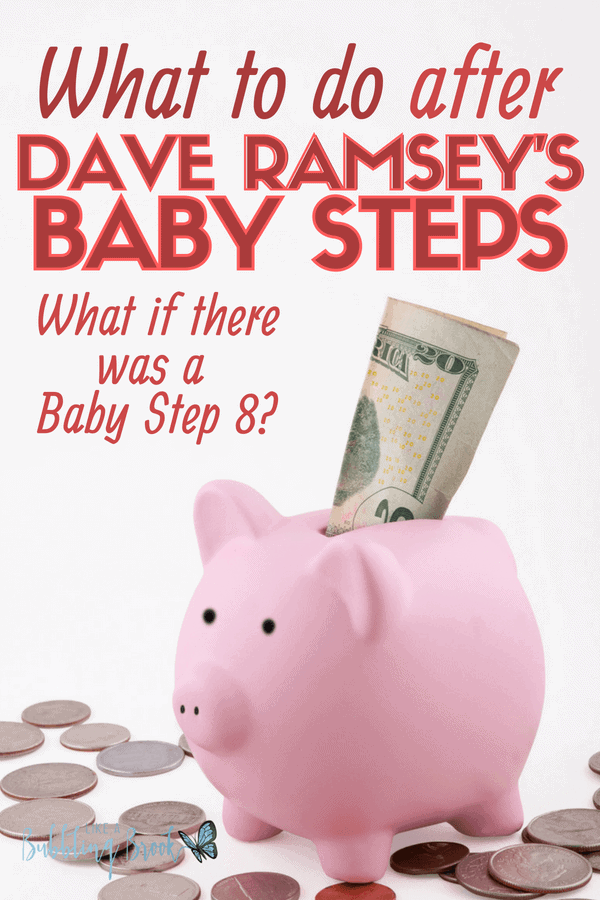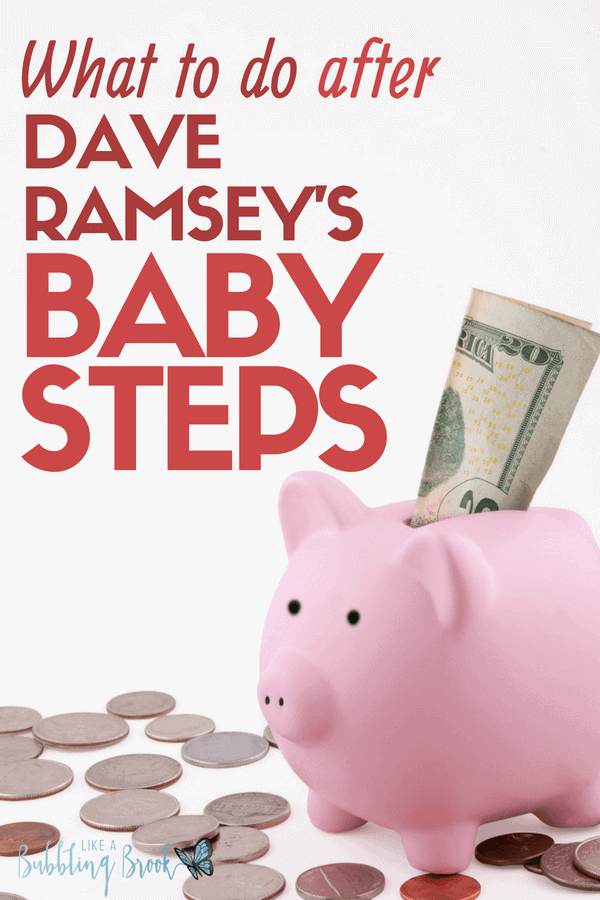Have you ever wondered what if Dave Ramsey added another baby step? Or what comes after Dave Ramsey baby steps? We’re debt free and well-acquainted with his seven baby steps, so we know that when you get to step 7 you may feel like you want another goal to strive for — you’ve grown accustomed to reaching for the next level. But, after step 7, what’s next? Where do you go from there?
If there was a next step, I believe we’d need to examine more closely what Baby Step 7 looks like, and then progress from there. Building wealth can happen a myriad of ways, but as you build wealth, you also want to learn how to keep as much of it as possible. We don’t want to pay extra income taxes if we don’t need to! That’s why, if there was a Baby Step 8, I believe it would be to max out your pre-tax investments.

Table of Contents
Since we became debt-free (you can read our debt free story here), I’ve added several Dave-inspired posts for my readers, including:
- Dave Ramsey Budget Forms For When You’re Struggling To Stay Afloat
- How We Paid For Christmas One Year By Earning Amazon Gift Cards
- 13 Things Dave Ramsey Fans Wish You Knew
- 50 Cheap Meals Your Family Will Love
…and more!
First, Remember the 7 Dave Ramsey Baby Steps
- Baby Step 1: Build your $1,000 starter emergency fund
- Baby Step 2: Use the debt snowball to pay off all your debt (except for your house)
- Baby Step 3: Save 3-6 months expenses (as your fully funded emergency savings)
- Baby Step 4: Invest 15% of your income for retirement
- Baby Step 5: Begin college savings for your children
- Baby Step 6: Pay your home off early
- Baby Step 7: Build wealth and give generously

After Dave Ramsey’s Baby Steps
Remember, I’m not your financial advisor. These are my opinions, based on my own research and experiences. Finances aren’t one-size-fits-all, so it’s always wise to seek professional help from an advisor before making any big financial decisions.
Max Out Your 401K
If you’re still only putting away 15% of your income for retirement (like in Baby Step 4), consider increasing your percentages. Does your employer offer a 401K? Can you max out your 401K contributions? Those are pre-tax and will reap huge savings on your tax bill. If you contribute the max of $19,500 (2020 max, if you’re under the age of 50), that’s a whopping $19,500 you aren’t paying taxes on this year. If you’re over the age of 50, you can contribute an additional $6,500, allowing you to put away $26,000 in pre-tax dollars.
Max Out The HSA
Another pre-tax savings option is an HSA account. If you have a compatible high-deductible insurance plan, you can put away $7,100 for your family’s medical savings in 2020. This is unique because not only is it pre-tax dollars, but it’s not taxed upon withdrawal, either! And the growth is tax free, too. Keep in mind these funds must be used for medical related expenses / health related costs.
Max Out Traditional IRAs
What you put away to your traditional IRA for yourself and your spouse also offers pre-tax savings. If you’re the age of 50, you can save $6000 tax free in 2020. If you’re 50 or over, you can save $7000. You and your spouse can each have one of these IRAs. Even if there is a stay-at-home spouse, they should qualify for a Spousal IRA in their name.
What About The Roth IRA?
If you don’t have a Roth IRA, and you qualify for one, I would max that out in Baby Step 8 as well. While it’s not pre-tax, you don’t pay taxes upon withdrawal of your earnings after the age of 59.5, as long as your Roth has been open for at least 5 years. (There are a few more rules that may or may not apply to you, so be sure to consult with an investment or tax professional while you’re creating your long-term plan.)
Personal Examples
My favorite personal example of someone who’s been able to leverage all of his pre-tax savings is told by Justin, at the blog Root of Good. His goal was to shrink his take-home pay as much as possible. He outlines how we was able to minimize his taxes through pre-tax savings and explains what worked for their family in his blog post $150,000 Income, $150 Income Tax.
You might notice Justin was able to save enough money (and lower his expenses) to the point where he could retire from a traditional job at the young age of 33.
Similarly, if you’re feeling especially motivated, you could learn more about how to create a plan to retire early at the Mr. Money Mustache blog. It’s all outlined in this post: The Shockingly Simple Math Behind Early Retirement.
How We Keep Track Of It All
With money going so many different places, it can feel a little overwhelming to keep an eye on it all. You can easily track your net worth, cash flow, investments, retirement accounts, and more by opening a free account at Personal Capital. This is what we use.
With Personal Capital you can see everything into an easy-to-read dashboard, and it also gives you some pretty cool reports. I like their retirement planner best. It helps you plan how much you need to save each month for retirement so you can reach your goals. Check them out (for free) here.
Have you reached the end of the Dave Ramsey Baby Steps and wondered, “What’s next?” Have you already began to max out your pre-tax accounts? What else did you do after Dave Ramsey Baby Steps 1-7?
I hope this post was helpful to you! If you want to find ways to lower your expenses so you can save more, one simple way to do that is to reduce your food costs. Click here to grab my printable Beans + Rice Budget Meal Plan.
Let’s talk again soon,

The fine print: Keep in mind I don’t know your exact financial or tax situation, and I’m not a financial or tax advisor. It’s always best to consult an advisor who knows your situation personally. I’m merely sharing what I’ve learned; it’s up to you to verify with professionals.



Leave a Reply